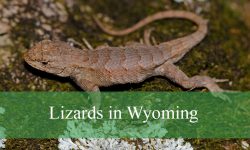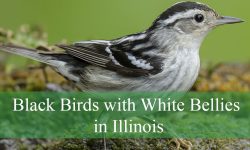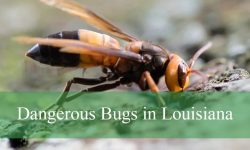Known as “the State of Great Lakes,” Michigan is home to more than 11,000 lakes and the world’s longest freshwater coastline. The state is home to a wide variety of birds and animals due to its abundance of freshwater.
In the picturesque state of Michigan, birdwatchers are often enchanted by the sight of yellow birds gracing the skies and treetops. The yellow birds in Michigan, such as the charming American Goldfinch and the melodious Yellow Warbler, bring vibrant bursts of color to the state’s diverse habitats.
In this article, we will explore about 40 species of yellow birds that can be found in Michigan, along with their characteristics and how to identify them.
Different Types of Yellow Birds in Michigan
Common Yellowthroat
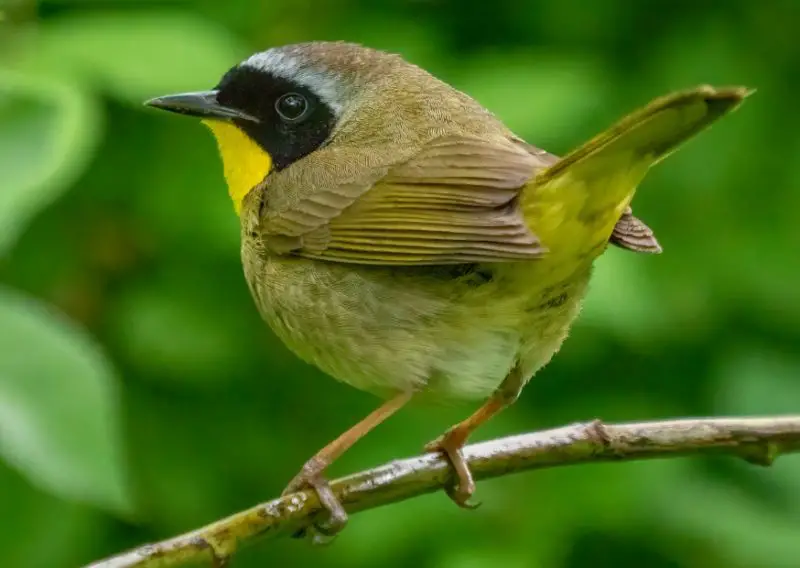
Common Yellowthroats are frequently seen in Michigan from May to October, appearing in 27% of summer checklists. These small songbirds have brownish backs and bright yellow underparts, with males displaying a distinctive black mask.
Measuring 4.3-5.1 inches long with a 5.9-7.5 inch wingspan, they inhabit marshy areas and brushy fields. Their nests, built by females near the ground, use grass and sedges. Attract them with dense vegetation and native plants.
Baltimore Oriole Female
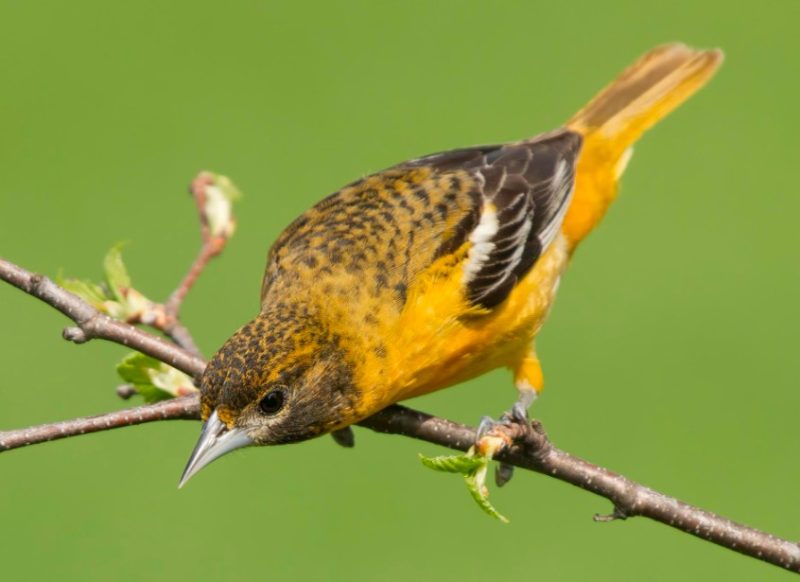
Female Baltimore Orioles are yellowish underneath and on the head, with grayish-brown wings and brownish-yellow backs. Slightly smaller and more slender than a Robin, they are a vibrant sign of spring in eastern North America.
Measuring 6.7-7.5 inches long with a 9.1-11.8 inch wingspan, they breed in eastern and central states. Attract them with oranges, sugar water, and fruiting plants. They forage for insects and fruit, often visiting backyards.
American Goldfinch
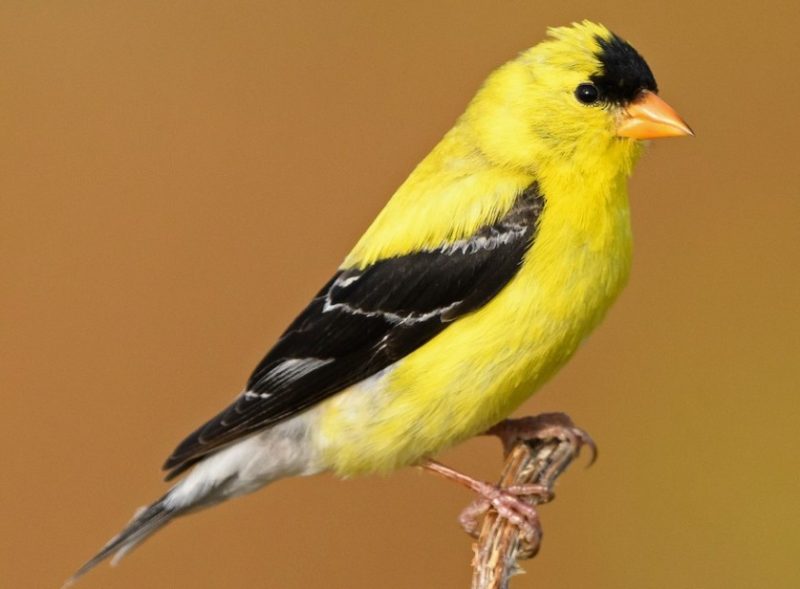
American Goldfinches are vibrant birds found in Michigan year-round, identified by males’ bright yellow and black plumage in spring, while females and winter males are duller brown.
They measure 4.3-5.1 inches in length with a wingspan of 7.5-8.7 inches. Preferring weedy fields, suburbs, and backyards, they forage for sunflower, thistle, and aster seeds. Their nests, built in shrubs, use plant material and spider webs.
Cedar Waxwing
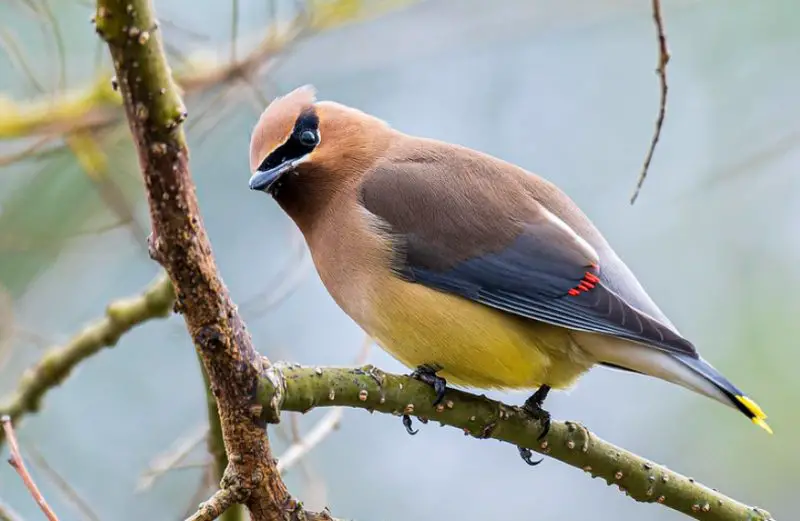
Cedar Waxwings, found in Michigan from May to October, are elegant birds with pale brown heads, chests, and crests, gray backs and wings, and pale yellow bellies. They feature a black eye mask and red wingtips.
Measuring 5.5-6.7 inches long with an 8.7-11.8 inch wingspan, they inhabit berry bushes, woodlands, and towns. Cedar Waxwings feed on fruit and insects and nest in trees using twigs and grass.
American Redstart Female
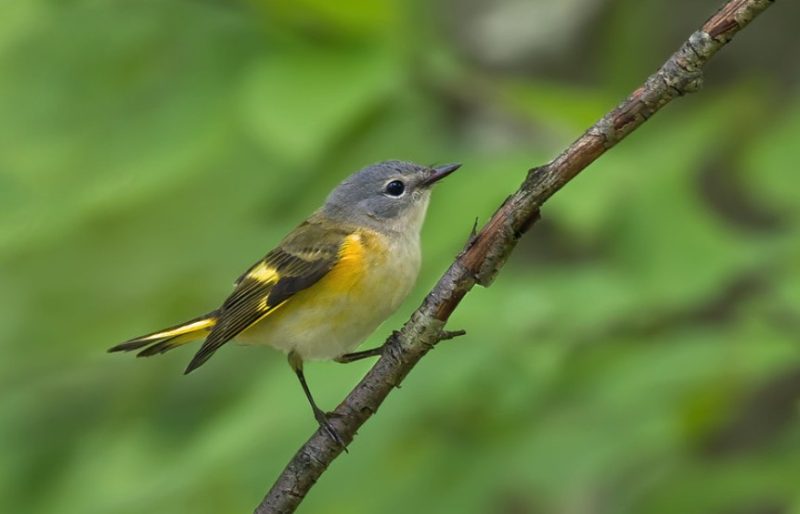
Female American Redstarts, spotted in Michigan from May to November, are olive-gray with yellow patches. Measuring 4.3-5.1 inches long with a 6.3-7.5 inch wingspan, they breed in eastern US and Canada.
They inhabit deciduous woodlands and backyards, eating insects and berries like serviceberry. Their nests, built near tree trunks, are made of bark and grass. Attract them with berry plants such as magnolia.
Nashville Warbler
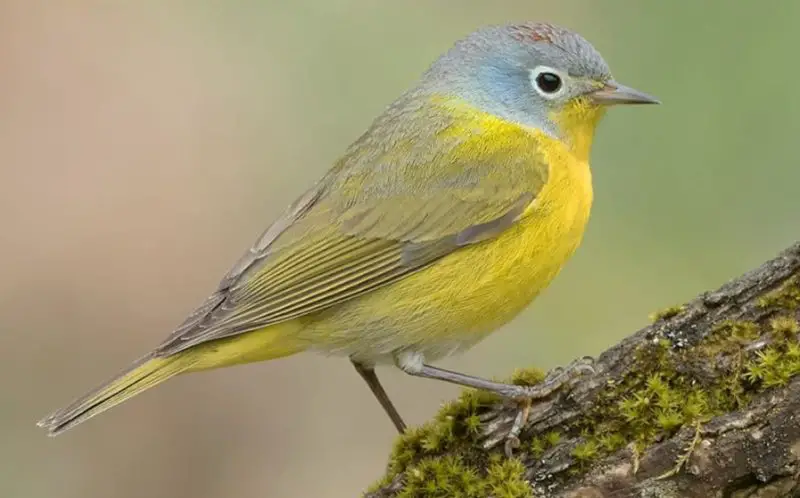
Nashville Warblers breed in northern Michigan but are often seen during migration in the southern part of the state. They have yellow underparts with white lower bellies, greenish-yellow backs, gray heads, and white eyerings. Females and juveniles are less bright.
Measuring 4.3-5.1 inches long with a 6.7-7.9 inch wingspan, they inhabit scrubby areas and low deciduous forests. Attract them with suet in winter in southern US states.
Yellow-rumped Warbler
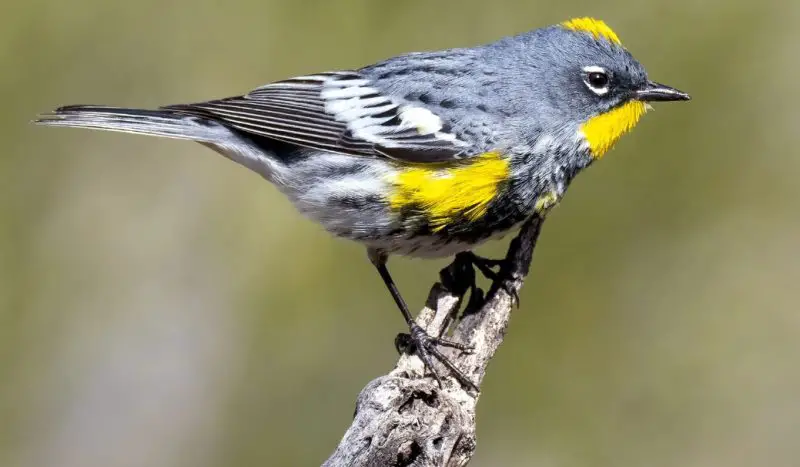
Yellow-rumped Warblers spend winter in southern Michigan, peaking in numbers during migration in April-May and September-October, appearing in up to 32% of checklists. These warblers are gray with yellow flashes on the face, sides, and rump, and white in the wings. Females and winter birds are browner, turning bright yellow and gray in spring.
Measuring 4.7-5.5 inches long with a 7.5-9.1 inch wingspan, they breed in Canada and the Rockies. They favor coniferous forests and fruiting shrubs.
Black-throated Green Warbler
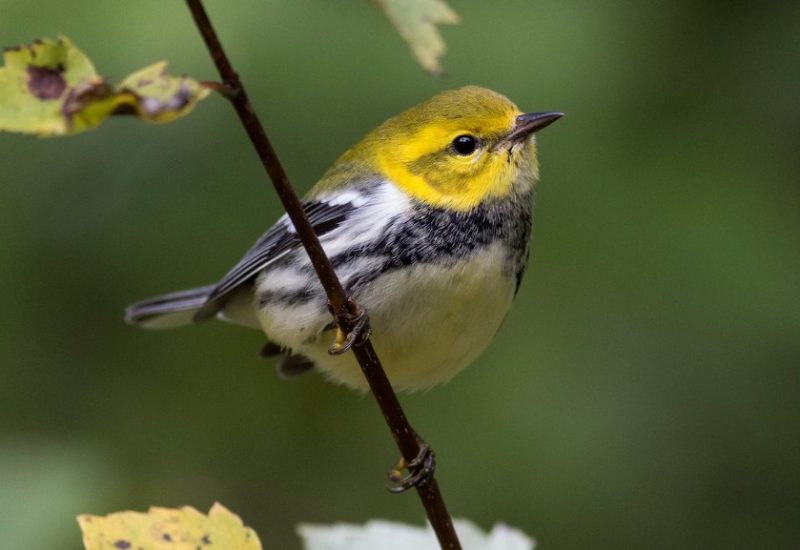
Black-throated Green Warblers are summer visitors to Michigan, seen from April to October, appearing in 9% of checklists. These small songbirds have yellow faces and heads, olive-yellow backs, and whitish underparts with black streaking. Males have prominent black throat patches, while females and juveniles have smaller patches.
Measuring 4.3-4.7 inches long with a 6.7-7.9 inch wingspan, they inhabit high forest canopies and feed on insects. Attract them with mature trees.
Palm Warbler
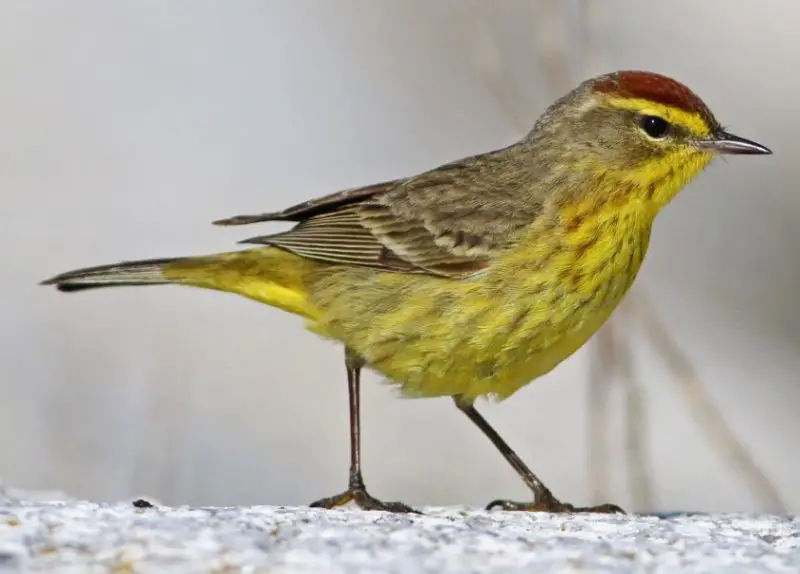
Palm Warblers are seen in Michigan during migration, mainly from April to June and August to October, peaking in May. Identified by their rusty red crown and browny-olive body, they breed in Canada and migrate through eastern US states.
Measuring 4.7-5.5 inches long with a 7.9-8.3 inch wingspan, they inhabit weedy fields and forest edges, foraging on the ground. Attract them with native insect-attracting plants and berry-producing shrubs.
Scarlet Tanager Female
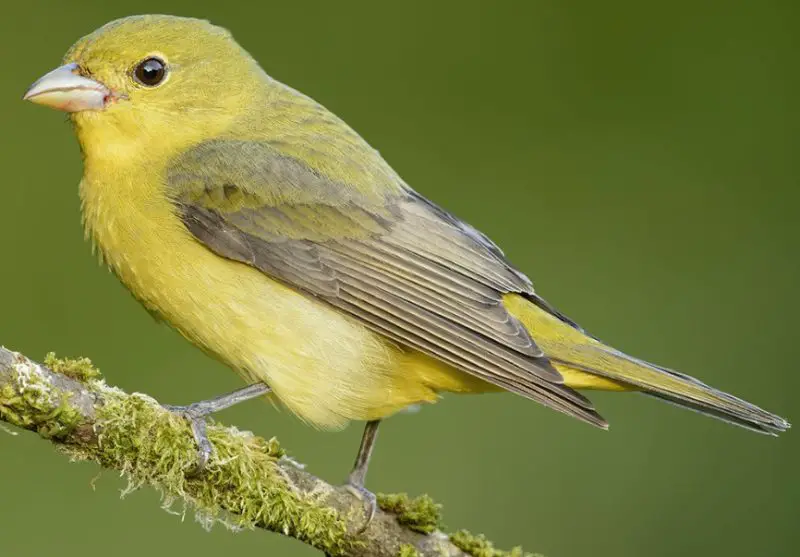
Female Scarlet Tanagers, seen in Michigan from April to mid-December, are yellow with darker wings and tails, while males are bright red with black wings and tails before molting.
Measuring 6.3-6.7 inches long with a 9.8-11.4 inch wingspan, they breed in eastern forests and migrate to South America. They stay high in the canopy, foraging for insects. Attract them with berry plants like blackberries and raspberries.
Eastern Meadowlark
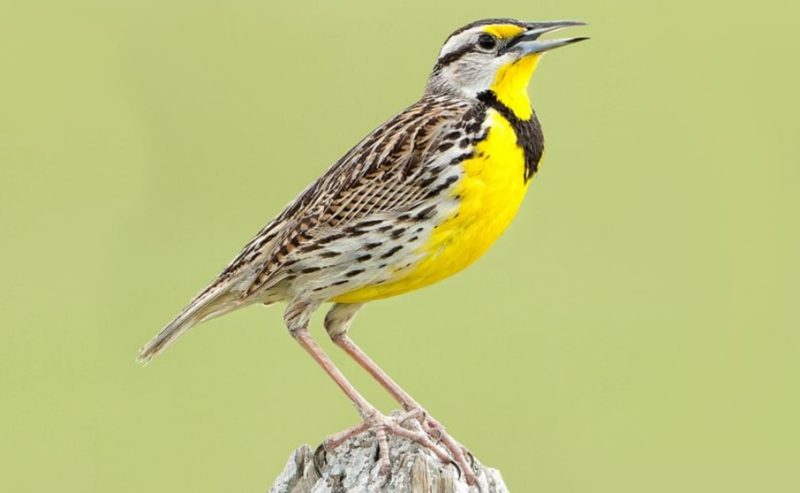
Eastern Meadowlarks, spotted mainly during Michigan’s breeding season and recorded in 5% of summer checklists, are medium-sized songbirds. They feature bright yellow undersides, pale brown bodies with black markings on the back, and a distinctive black chest band.
Measuring 7.5-10.2 inches long with a wingspan of 13.8-15.8 inches, they inhabit grasslands and prairies, feeding on insects. Their flute-like whistles mark their presence in spring, though they face near-threatened status due to habitat loss.
Magnolia Warbler
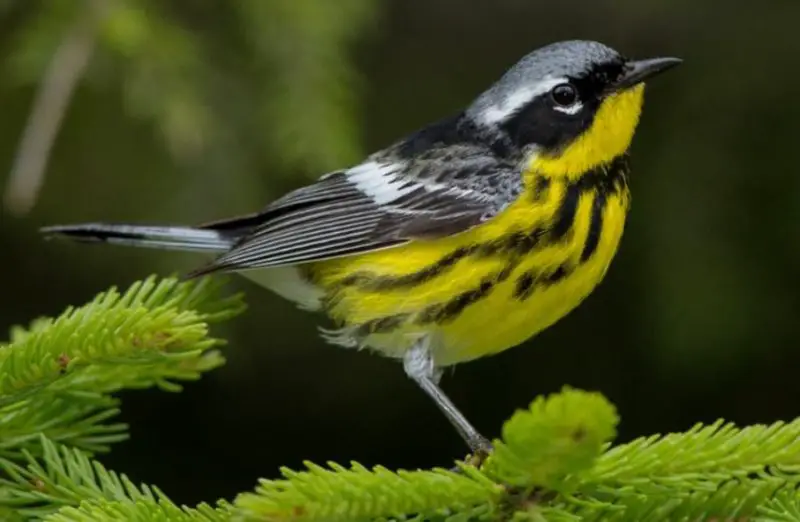
Magnolia Warblers are seen in Michigan mainly during spring and fall migration, with some breeding in the north. Males have black backs and yellow undersides with distinctive black streaking forming a ‘necklace’. Females are grayer on the back and lack belly streaking.
Measuring 4.3-5.1 inches long with a 6.3-7.9 inch wingspan, they breed across Canada and northeastern US states, migrating through the eastern US. They nest in loose grassy structures near conifer trunks and feed on insects.
Pine Warbler
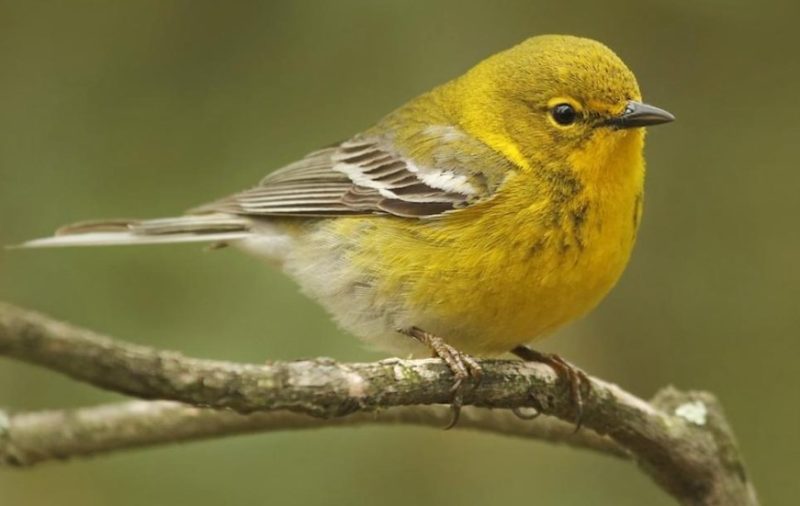
Pine Warblers, found in Michigan during summer from April to October and recorded in 6% of checklists, are small yellow birds with olive backs, white bellies, and gray wingbars. Females may appear browner with more white on their bellies. They measure 5.1-5.5 inches in length with a wingspan of 7.5-9.1 inches.
Breeding in northeastern US states, they migrate to southeastern states or stay year-round. You’ll find them high in pine trees, feeding on insects like caterpillars and beetles, occasionally switching to fruit and seeds in colder weather.
Yellow-throated Vireo
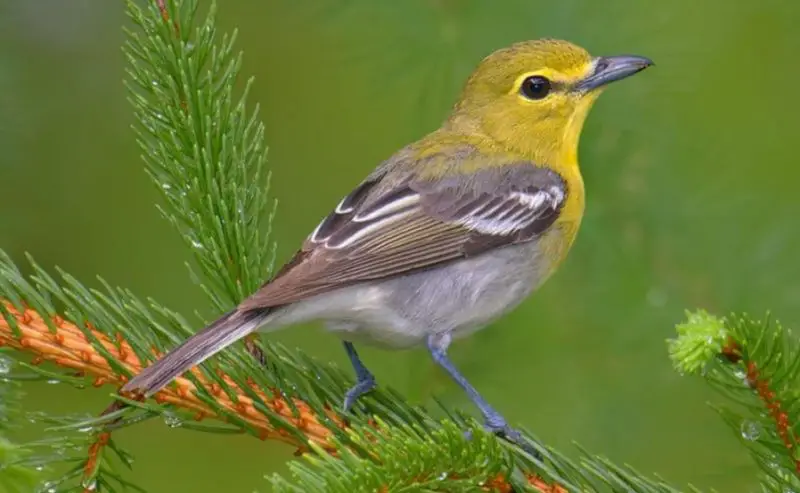
Yellow-throated Vireos, found in Michigan from mid-April to October and noted in 6% of summer checklists, are bright yellow and gray with olive heads, yellow throats, and white bellies. They have grayish-brown backs with white streaks, measuring 5.1-5.9 inches with a wingspan of 9.1 inches.
They breed in eastern US states and migrate to Central and South America for winter. Spot them in mixed woodlands hunting insects and occasionally berries. Their nests are hanging cups made from bark, grass, and spider webs attached high in trees.
Canada Warbler
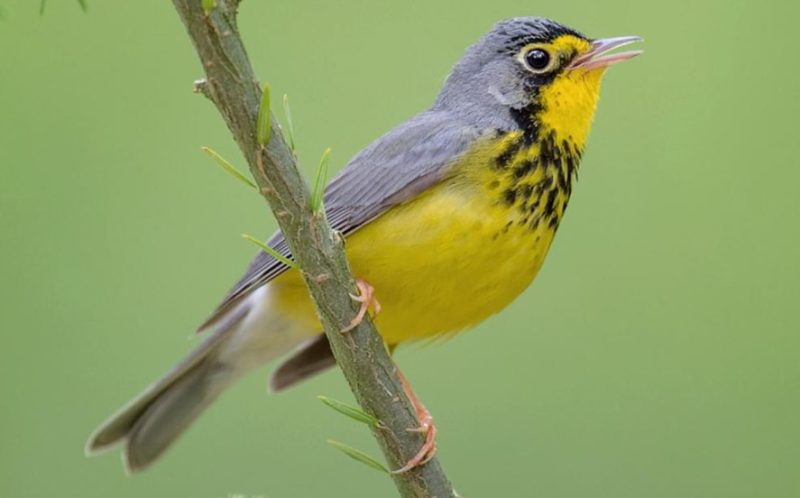
The Canada Warbler migrates through Michigan during spring and fall, peaking in May on 5% of checklists. They resemble the Magnolia Warbler but have grayish-black backs and a distinct black ‘necklace’ that ends at the chest. Their chests, bellies, and throats are yellow. Females and juveniles are paler with less prominent markings.
They are 4.7-5.9 inches (12-15 cm) long, weigh 0.3-0.5 ounces (9-13 g), and have a wingspan of 6.7-8.7 inches (17-22 cm). Nesting in Canada and the northeastern US, they winter in western South America, favoring dense forests for insect foraging.
Orange-crowned Warbler
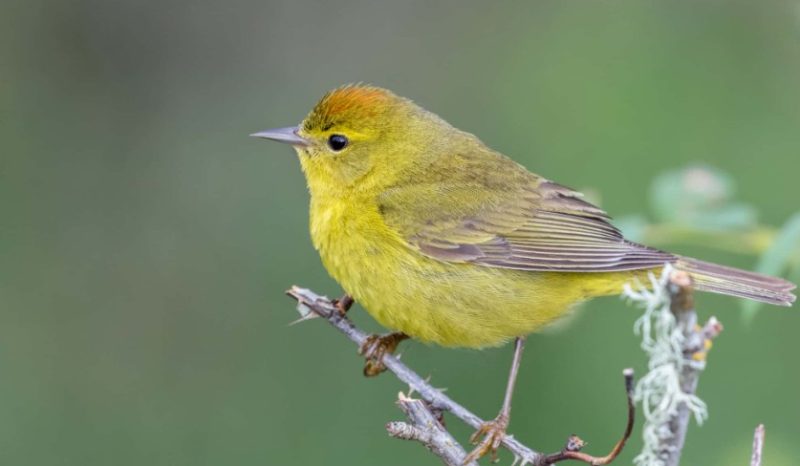
Orange-crowned Warblers migrate through Michigan in May and October, known for their subdued yellow-olive plumage, more vivid along the Pacific Coast, with their orange crown rarely visible. These small birds, 4.3-5.5 inches (11-14 cm) long and weighing 0.3-0.4 ounces (7-11 g), breed in Canada and the western US before traveling to the Pacific, East, and Gulf Coasts, and Mexico.
They feed on spiders, insects, fruits, berries, and seeds in shrubs and low vegetation, nesting near or on the ground with nests made of leaves, twigs, and grass, laying up to six eggs. Attract them with suet, peanut butter, or sugar water in hummingbird feeders.
Hooded Warbler
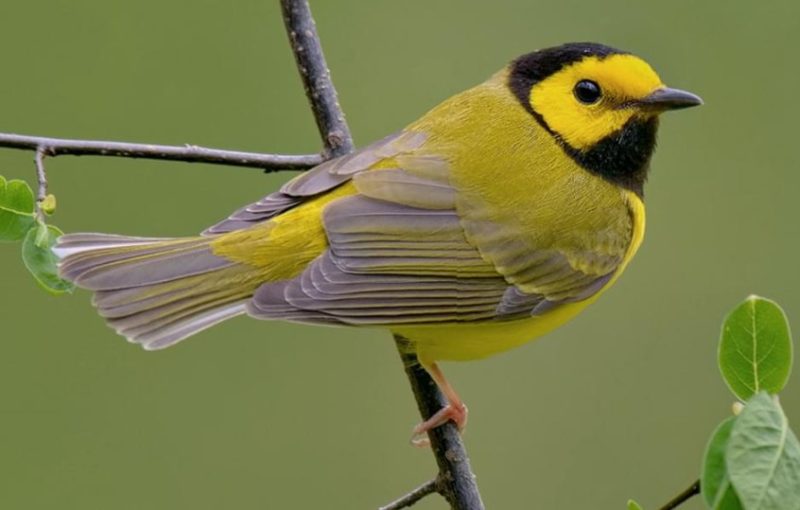
Hooded Warblers breed in Michigan from April to mid-October. Males have bright yellow faces, black hoods and throats, yellow undersides, and olive-green backs. Females and juveniles are uniformly yellow. They are 5.1 inches (13 cm) long, weigh 0.3-0.4 oz (9-12 g), with a wingspan of 6.9 inches (17.5 cm). After breeding in the eastern US, they migrate to Central America and the Caribbean for winter.
Found in forests with dense understories, they hunt insects and spiders. Nests are built in shrubs near forests using bark, grass, and plants, where they lay about four eggs. Attract them with native plants that provide insects and shelter.
Dickcissel
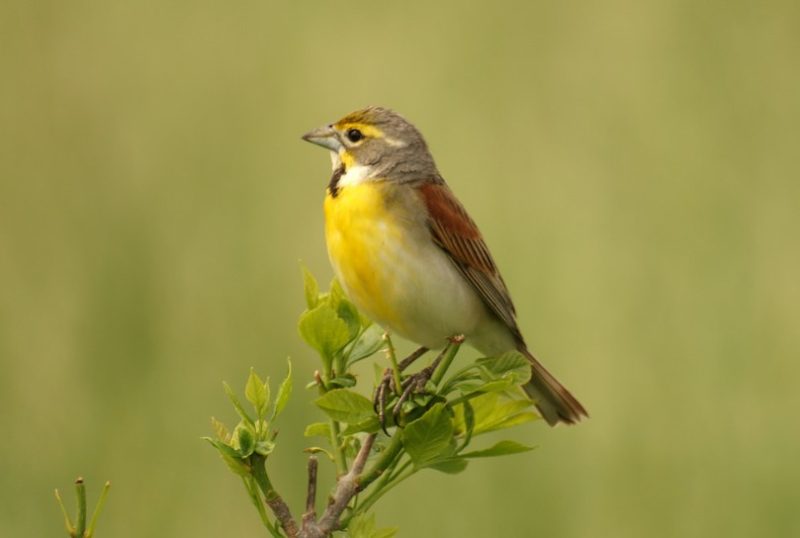
Dickcissels breed in Michigan from April to October. Males are notable for their black throat patch, yellow chest, and striking yellow eyebrow against a grayish head. Females have similar markings but are paler and lack the black throat patch. They measure 5.5-6.3 inches (14-16 cm) in length, weigh 0.9-1.4 oz (25.6-38.4 g), with a wingspan of 9.8-10.2 inches (24.8-26 cm). Breeding in the Central and Great Plains of the US, they migrate to Mexico, Central America, and northern South America.
Found in meadows, prairies, and grasslands, they feed on insects like grasshoppers and seeds. Nests, typically in shrubs and trees, are built with weeds, grass, and leaves, lined with fine grass and animal hair, where females lay up to six eggs that hatch in two weeks.
Prothonotary Warbler
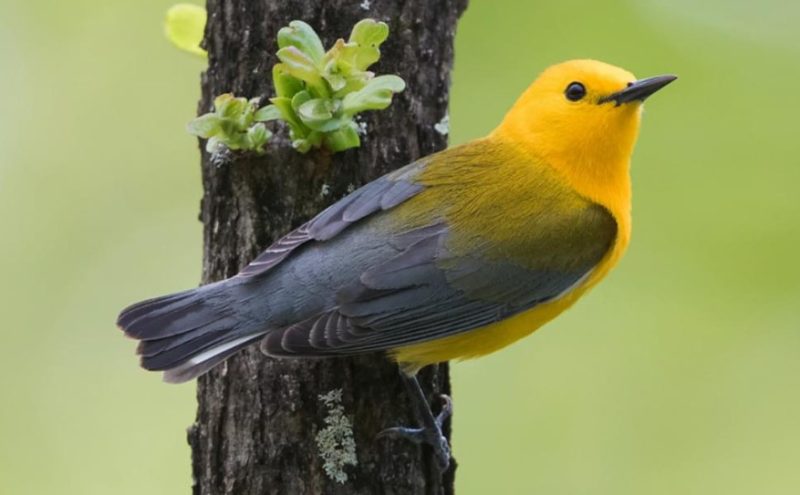
During the breeding season from mid-April to September, Prothonotary Warblers grace Michigan with their bright yellow plumage, highlighted by blue-gray wings and tails. These large Warblers, identifiable by their thick black beaks and white underparts, typically inhabit eastern US states, wintering in Mexico and northern South America.
Often found near streams and wet woodlands, they hunt spiders, insects, and snails, adding fruit and seeds to their diet during winter. Nesting in abandoned woodpecker holes near water, they raise up to seven eggs, a process lasting about three weeks.
Yellow-headed Blackbird
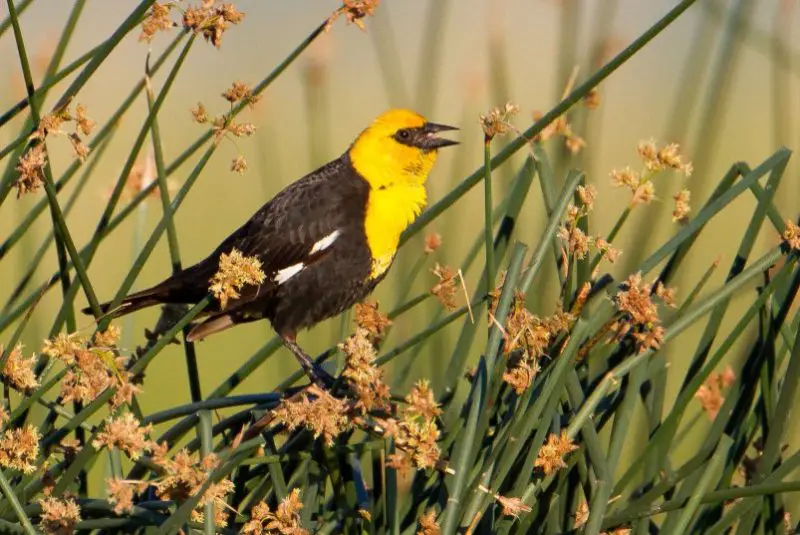
Yellow-headed Blackbirds are a rare sight in Michigan, primarily observed during summer from mid-April to June. These striking birds feature glossy black bodies, vibrant yellow heads and chests with white wing patches in males. Females are brown with a muted yellow head. Larger than Red-winged Blackbirds, they measure 8.3-10.2 inches (21-26 cm) with a wingspan of 16.5-17.3 inches (42-44 cm), weighing between 1.6-3.5 ounces (44-100 g).
They breed in western and prairie wetlands, nesting among reeds and foraging for insects. In winter, they migrate to Southwest states and Mexico, consuming seeds and grains.
White-eyed Vireo
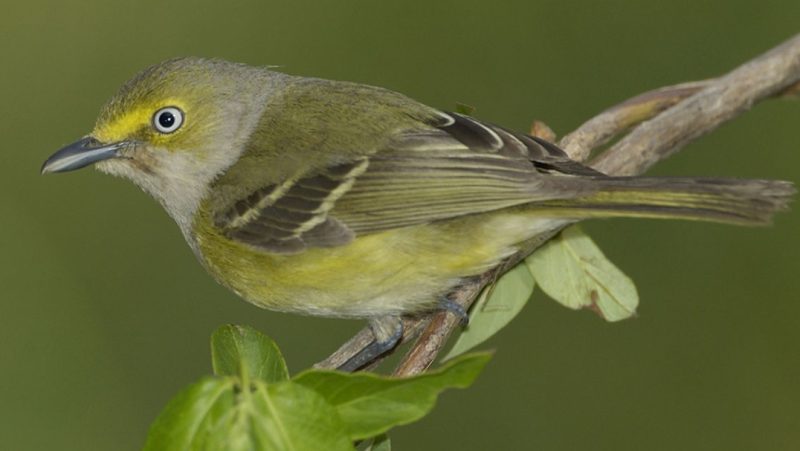
White-eyed Vireos make appearances in Michigan during summer, peaking in May during their migration. Identified by their gray heads with yellow accents around the forehead and distinct white eyes, these birds boast white throats and chests, yellow sides, greenish backs with darker wings, and two white wingbars. They measure 4.3-5.1 inches (11-13 cm) with a wingspan of 6.7 inches (17 cm), weighing between 0.3-0.5 ounces (10-14 g).
Found in overgrown pastures and brambles, they feed on insects and spiders, occasionally consuming berries in winter.
Prairie Warbler

Prairie Warblers, occasionally seen in Michigan during summer, are small songbirds characterized by olive-green backs and vibrant yellow throats and bellies. They sport black streaks along their sides and a distinctive dark semicircle below the eye. Females exhibit a more subdued coloration.
With a length of 4.3 inches (11 cm) and weighing between 0.2-0.3 ounces (6.4-8.8 g), they breed in eastern and southeastern US states, wintering in Florida, the Caribbean, and coastal Central America. Found in fields and forests, they feed on insects, spiders, and snails, often observed bobbing their tails while foraging.
Yellow-throated Warbler
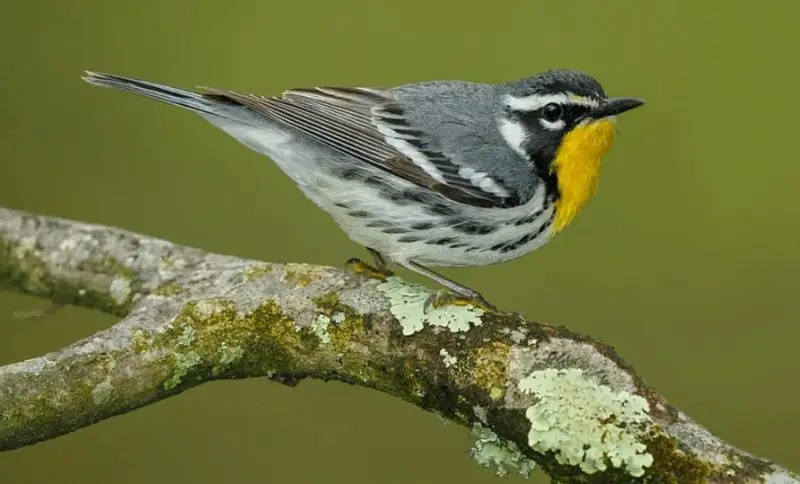
Yellow-throated Warblers, seen sparingly in Michigan during summer, exhibit gray and white bodies adorned with black stripes and vibrant yellow throats. Their underside reveals white bellies and tails. Females and juveniles have paler markings.
With a length ranging from 5.1 to 5.5 inches (13-14 cm) and weighing 0.3-0.4 ounces (9-11 g), they breed in the southeastern US and winter in Florida, the Caribbean, and Central America’s Gulf Coast. Often found atop pine trees hunting insects, they construct nests in Spanish moss, weaving grasses and moss into cup-shaped structures.
Summer Tanager Female
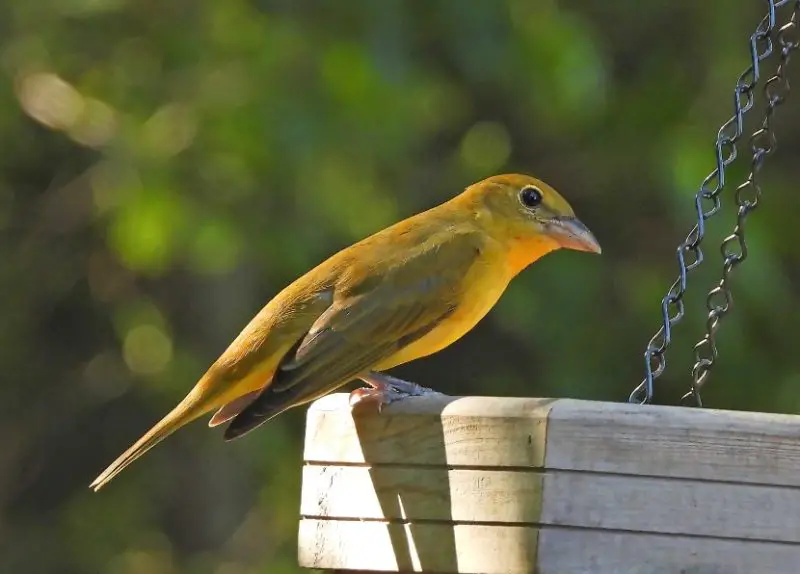
During summer in Michigan, the female Summer Tanager can be observed, though they are most commonly seen during the May spring migration. Unlike their vibrant red male counterparts, females and juveniles are predominantly yellow with touches of green on their backs. They measure about 6.7 inches (17 cm) in length and weigh around 1.1 ounces (30 g).
Summer Tanagers breed in southern and eastern US states before migrating to Central and South America for winter. Found in open woodlands, they feed on bees and wasps in flight, using a unique technique to remove stingers before consuming their prey.
Western Meadowlark
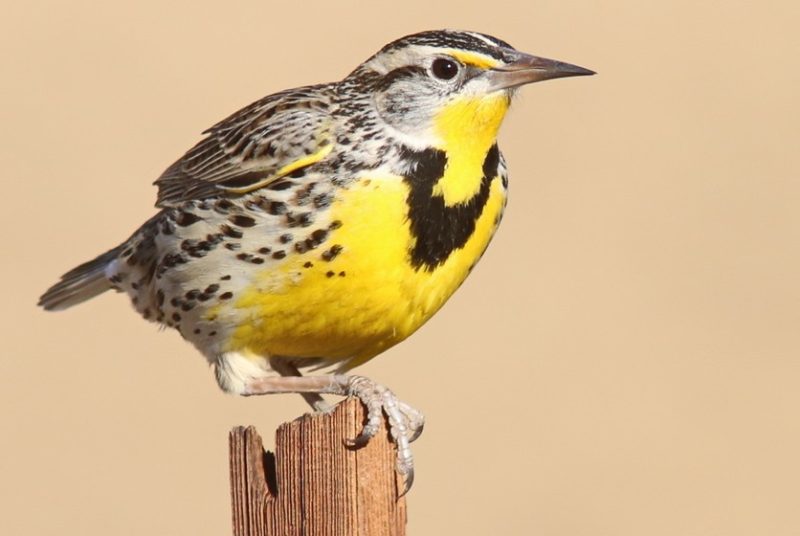
Western Meadowlarks, occasionally seen in Michigan during summer, are known for their bright yellow bellies and melodious songs that uplift spirits. Belonging to the blackbird family, they resemble Robins in size, featuring brown and white upperparts and a distinctive black V-shaped band across their yellow chests, which fades to gray in winter.
Measuring between 6.3 to 10.2 inches (16-26 cm) with a wingspan of 16.1 inches (41 cm), they breed in northern US states and Canada, migrating southward for winter. Typically found in grasslands and meadows, they feed on insects and seeds, nesting in ground depressions lined with soft grasses.
Western Kingbird
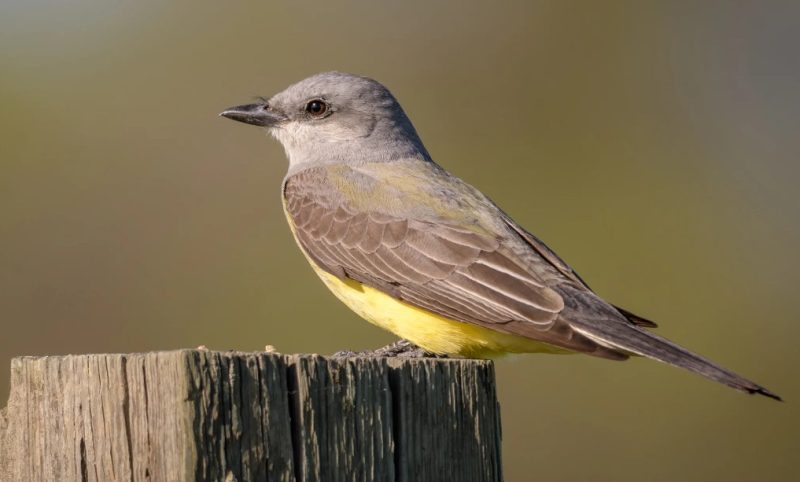
Western Kingbirds, occasionally spotted in Michigan during summer, are notable for their large size and striking appearance. They feature yellow bellies, whitish chests, gray heads, grayish-brown wings, and distinctive black tails edged in white.
With a length ranging from 7.9 to 9.4 inches (20-24 cm) and a wingspan of 15.0-16.1 inches (38-41 cm), they breed in western US states, the plains, and into Canada, migrating to Mexico and Central America for winter. Found in open habitats, they perch on fences and utility lines, capturing insects in mid-flight.
Blue-winged Warbler
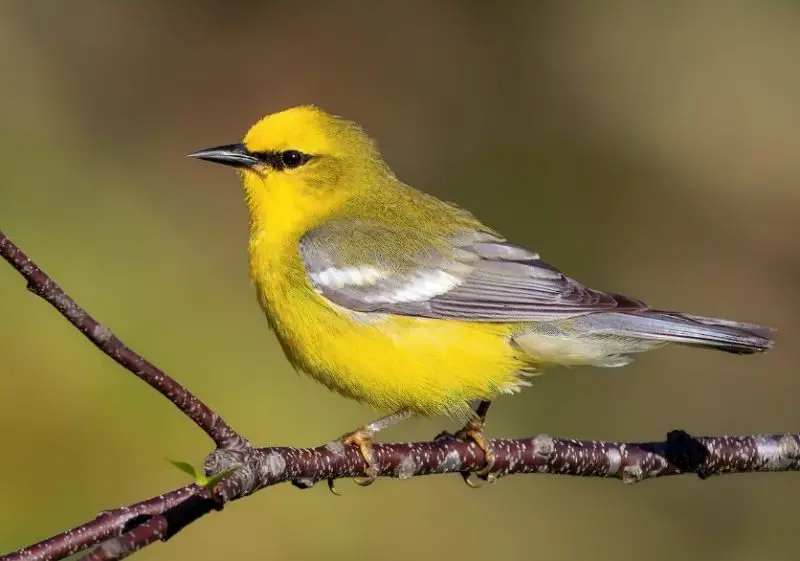
The Blue-winged Warbler, seen in Michigan from April to September and in 3% of summer checklists, is named for its bluish-gray wings. Adults are yellow-green on top with a prominent black eye line extending across the eye, resembling an angry look. Their bright yellow breast and belly are shared by both sexes, with females slightly paler.
Found in eastern US states, they migrate to Mexico, Central America, and the Caribbean for winter. They prefer abandoned fields, forest edges, and thickets for foraging insects and spiders.
Cape May Warbler
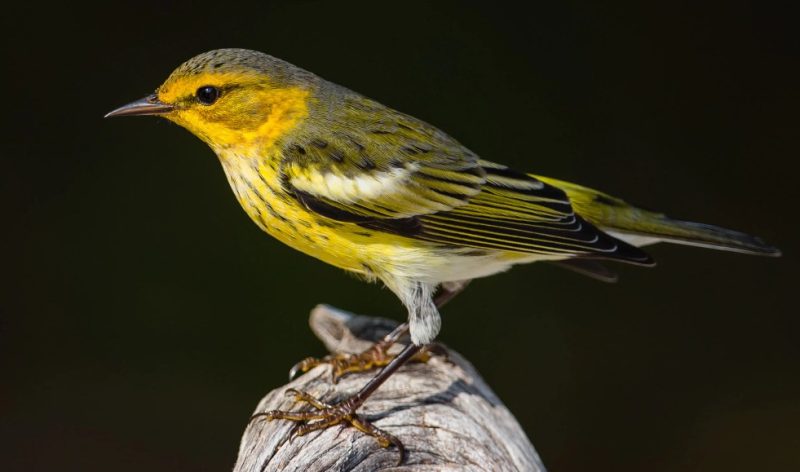
The Cape May Warbler, seen in Michigan mainly during spring and fall migration, stands out with its male’s chestnut cheeks, dark cap, and distinctive yellow neck ring. Males are mottled yellow-olive above and yellow with dark streaks below, distinguishing them from females and immature birds. They migrate to breed in Canada, wintering in the Caribbean and Central America.
Found in spruce forests during breeding and in diverse habitats in migration, they feed on spruce budworms in summer and nectar in winter.
Wilson’s Warbler
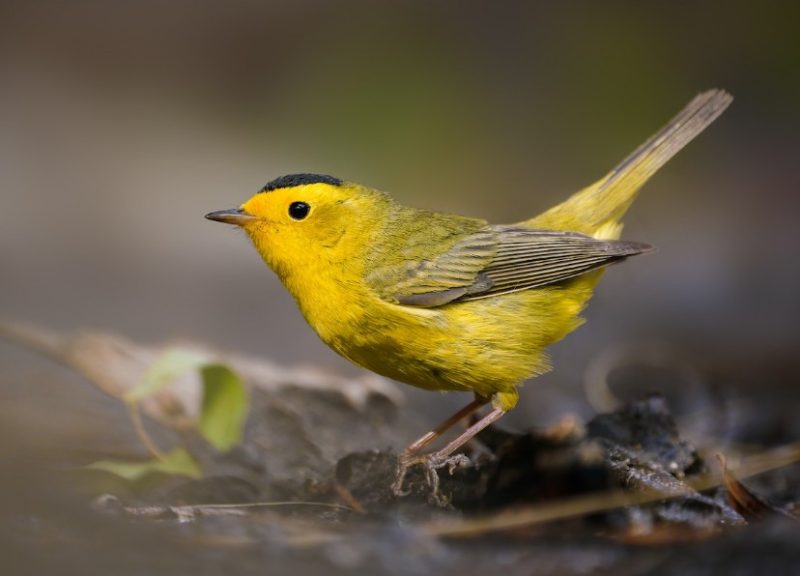
Wilson’s Warblers, migrating through Michigan in May and September, are identifiable by their small, round shape and bright yellow color. Males sport a large black cap, while females have a smaller one. They breed in Canada, Alaska, and northwestern US states, migrating across all US states. During winter, they reside in Mexico and Central America.
Found near streams and forest edges, they feed on insects, larvae, and spiders. Their nests, hidden on the ground near shrubs, are made from leaves, grass, and moss, lined with soft materials.
Orchard Oriole Female
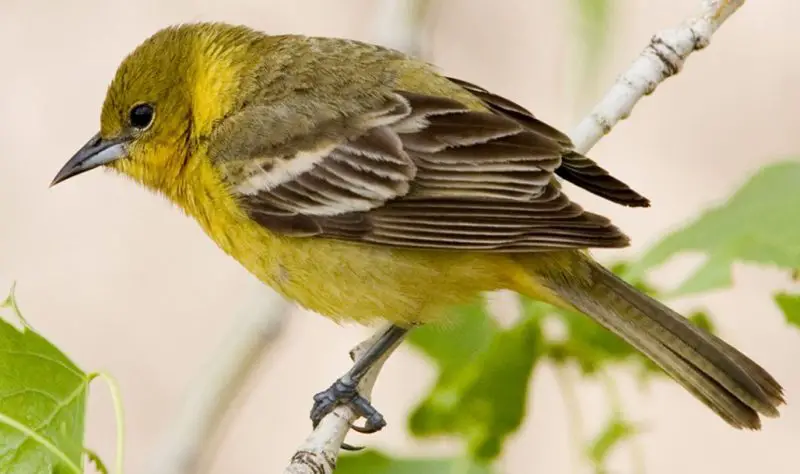
Orchard Orioles, identified by their greenish-yellow females and boldly colored males with black heads and reddish undersides, breed in the eastern United States during summer before migrating to Mexico and Central America. They measure 5.9-7.1 inches (15-18 cm) in length, weigh 0.6-1.0 ounces (16-28 g), and have a wingspan of 9.8 inches (25 cm).
Found in open woodlands, along riverbanks, and in shrublands, they build hanging nests from grass. Their diet includes insects, nectar, and fruits like mulberries and chokeberries. Their vocalizations consist of jumbled whistles lasting 3 to 4 seconds.
Evening Grosbeak
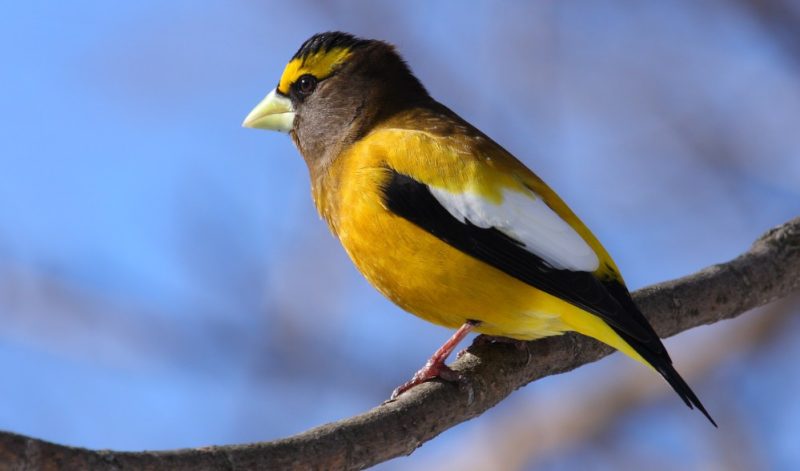
Evening Grosbeaks, with vibrant yellow and black markings, migrate and winter in Michigan. Adult males have yellow stripes above their eyes, black heads with gray necks, and yellow chests with white wing patches. Females and juvenile males feature greenish bills, gray bodies, and black and white wings. They measure 16-22 cm (6.3-8.7 in) long, weigh 38.7-86.1 g (1.37-3.04 oz), and have a wingspan of 30-36 cm (12-14 in).
Found year-round in southern Canada, they move south during food shortages, favoring forests, mountains, and winter backyard feeders for seeds and berries.

